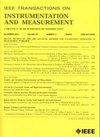Intelligent Measurement Method of Transmission Line Sag Based on Image and Laser Ranging Fusion
IF 5.9
2区 工程技术
Q1 ENGINEERING, ELECTRICAL & ELECTRONIC
IEEE Transactions on Instrumentation and Measurement
Pub Date : 2025-06-18
DOI:10.1109/TIM.2025.3580837
引用次数: 0
Abstract
Existing sag measurement systems are often hindered by complex workflows and heavy reliance on manual assistance. An intelligent sag measurement method, integrating image data and laser ranging technology, is proposed. Based on this method, an intelligent sag measurement system is developed to enable automatic coordinate collection and sag calculation. The method uses a laser rangefinder to measure distances on the transmission line, which is converted into 3-D coordinates using angular relationships from a spatial position model. Acatenary model is then applied to fit the data and calculate the sag value. In the system, a sag measurement algorithm is designed to automatically determine horizontal and pitch rotation parameters. Horizontal rotation angles are calculated by uniformly controlling rotation distances based on the number of measurement points. For pitch rotation, an AutoML-optimized BP neural network is constructed, using laser distances and image pixel differences as inputs. Model performance is evaluated using an absolute error threshold. The experimental results show that the proposed pitch angle prediction model achieves a coverage rate of 99.040% within the error tolerance range. The average mean absolute error (MAE) of the sag intelligent measurement system is 0.111 m, the average root mean square error (RMSE) is 0.140 m, and the average standard deviation is 0.129 m. The measurement time is improved by 24.390% compared to a total station.基于图像与激光测距融合的传输线垂度智能测量方法
现有的沉降测量系统经常受到复杂的工作流程和对人工辅助的严重依赖的阻碍。提出了一种结合图像数据和激光测距技术的智能垂度测量方法。在此基础上,开发了一套智能垂度测量系统,实现了坐标自动采集和垂度自动计算。该方法使用激光测距仪测量传输线上的距离,利用空间位置模型的角关系将其转换为三维坐标。然后应用悬链线模型对数据进行拟合,计算垂度值。在该系统中,设计了一种垂度测量算法来自动确定水平和俯仰旋转参数。水平旋转角度是根据测量点的数量统一控制旋转距离来计算的。对于俯仰旋转,以激光距离和图像像素差为输入,构建了一个自动优化的BP神经网络。使用绝对误差阈值评估模型性能。实验结果表明,所提出的俯仰角预测模型在误差容限范围内的预测覆盖率达到99.040%。该凹陷智能测量系统的平均绝对误差(MAE)为0.111 m,平均均方根误差(RMSE)为0.140 m,平均标准差为0.129 m。与全站仪相比,测量时间提高了24.390%。
本文章由计算机程序翻译,如有差异,请以英文原文为准。
求助全文
约1分钟内获得全文
求助全文
来源期刊

IEEE Transactions on Instrumentation and Measurement
工程技术-工程:电子与电气
CiteScore
9.00
自引率
23.20%
发文量
1294
审稿时长
3.9 months
期刊介绍:
Papers are sought that address innovative solutions to the development and use of electrical and electronic instruments and equipment to measure, monitor and/or record physical phenomena for the purpose of advancing measurement science, methods, functionality and applications. The scope of these papers may encompass: (1) theory, methodology, and practice of measurement; (2) design, development and evaluation of instrumentation and measurement systems and components used in generating, acquiring, conditioning and processing signals; (3) analysis, representation, display, and preservation of the information obtained from a set of measurements; and (4) scientific and technical support to establishment and maintenance of technical standards in the field of Instrumentation and Measurement.
 求助内容:
求助内容: 应助结果提醒方式:
应助结果提醒方式:


